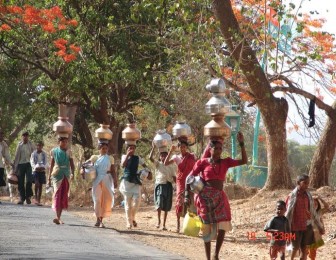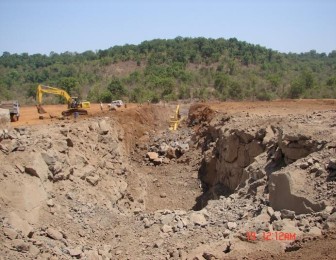The chapter on Urban Development in the 12th Five Year Plan Document reflects the main thrust of the Plan . faster, more inclusive and sustainable growth. It presents the Urban Vision, which states that "India's urban growth must be aligned with the objectives of inclusion and sustainability..." Elaborating the point, it adds that "The issue of allocation of water resource between rural and urban India needs to be addressed in ways that reduce intra-national tension. It is imperative that Indian cities and industries reinvent their water strategy with an aim to grow with minimal water and minimal waste generation (emphasis in original)."
That the ground reality is vastly different from this was amply evident in a meeting that took place in Mumbai on 18 December 2013. The meeting was called to discuss Issues about Dams for Mumbai Metropolitan Region. Twelve dams are planned or are under construction to supply water to various cities in the Mumbai Metropolitan Region (MMR). The cities include Greater Mumbai, Navi-Mumbai, Thane, Kalyan, Virar, Vasai and others.
Most of these dams . like Kalu, Shai, Suseri, Pinjal, Gargai - are being taken up without any environmental impact assessment or environmental management plan, and grossly violate many rules and regulations. They also face strong opposition from affected people and from several tribal organisations and movements working in the area.
The meeting in Mumbai was organised by the South Asia Network on Dams, Rivers and People (SANDRP), Shramik Mukti Sangathana, Jalbirdari and Keystone Foundation to highlight the issues raised by the construction of these dams and plan joint strategies to address the problems created by the projects. Close to 50 people, including people directly affected by these projects, representatives of tribal and people's movement groups, water experts, ecologists, social activists participated in the meeting.
While the meeting focused on these 12 dams around Mumbai, the significance of the issue goes far beyond the region since exactly the same kind of development . building dams in rural areas to bring water to cities from long distances . are being planned for almost all major cities in the country, for example the proposed Renuka dam in Himachal that is to bring water to Delhi,
Severe impact
A report that one of the organisers, SANDRP is preparing, notes that these 12 dams will "together submerge more than 22,000 hectares of land, including nearly 7000 hectares of forests, lakhs of trees and more than 750 hectares of Tansa Sanctuary. They will affect a minimum of 100,000 tribals who depend on the forests and their ancestral lands for livelihoods."
Yet, most of these projects do not even require an Environment Impact Assessment to be carried out. This is because a loophole in the Ministry of Environment and Forest (MoEF)'s EIA Notification 2006 requires an EIA only for dams that are meant for irrigation and hydropower. Dams for urban or industrial water supply do not require any EIA, no matter how big they are and how significant their impacts.

Tribals, even as they are impacted by dams meant for supplying water to Mumbai, themselves remain deprived of proper water sources. (Picture credit: Parineeta Dandekar / SANDRP.)

•
Bhama Askhed: Just another pawn
•
The 'Protocol' of vested interests
Even as the application for Forest Clearance was under consideration, the Chief Conservator of Forests noted that the construction on the project had already started, in gross violation of the law. In April 2012, the Forest Advisory Committee of the MoEF rejected the clearance and closed the file. Yet, just a year later, the FAC reopened the file and granted clearance to the project on the submission of the state Chief Minister. However, the local tribals' organization, the Shramik Mukti Sangathana has filed a case in the High Court and the Court has issued a stay order, so the work remains suspended for now.
A similar situation is seen in the case of the Balganga project. As Surekha Dalvi, senior social activist of the Shramik Kranti Sangathana points out, the work on the dam is 90 per cent over, and yet the land acquisition process has not taken place, with the preliminary notices under Section 4 (of the old Land Acquisition Act) being issued only in May 2013.
It is not only displacement issues which pose a serious problem. These dams are in the ecologically fragile Western Ghats, and many of them are within the Eco-Sensitive Area as declared under the Kasturirangan Committee Report. Large tracts of forest land are being submerged, including areas falling under Protected Areas. Further, as ecologist Shardul Bajikar says, these dams are coming up in the regions that represent very important corridors for wildlife movement and connectivity, and disruption in these corridors will impact the wildlife severely. Moreover, it is important to protect the ecology and forests of these areas as they provide critical eco-system services including drinking water.
It is ironic that these dams that are likely to severely impact the catchments of the water supply for the cities are being built precisely to take water to these cities. As Surekha Dalvi has pointed out, when they raised the issue of displacement of the people affected by Balganga dam, the concerned Minister told them that "we can manage the rehabilitation of your 1500 people, but we need these dams for the water needs of 1.5 crore people". However, this is possibly the biggest problem with the projects.

Illegal work at Kalu Dam. Pic credit: Parineeta Dandekar / SANDRP
Urban water supply: Shaky justification
In spite of the claims that these dams are necessary to supply water for the needs of many of the large cities of the MMR, there has been no proper study to show that these needs cannot be met by any other means. Brian Lobo, senior social activist of the Kastakari Sangathana, and part of the struggle against the Suseri dam, highlights the fact that many of the options to meet water needs had been identified by the authorities themselves, but were ignored. A possible reason is because dams provide an avenue for spending huge sums of money. It's not a coincidence that some of these dams have been a part of the Maharashtra irrigation scam that broke out last year.
Himanshu Thakkar, of SANDRP, water expert and member of the Planning Commission's Working Group for the 12th Plan for Urban and industrial Water supply, presented these options in detail. He pointed out that the "MMR has not done any sort of options assessment before pushing these projects and cursory review shows that many options exist." These include local water sources, rainwater harvesting, groundwater use, sewage treatment and reuse, increasing water supply efficiency etc., all of which should be the first choices for meeting the water needs of the cities.
Giving one example, Thakkar states that Mumbai receives a supply of 3520 MLD and almost 800 MLD of this is wasted in losses. This is equivalent to the supply from two of the planned dams. If such losses can be controlled, then at least some of the dams will no longer be required.
Another case in point is that many of these cities don't even have adequate capacity to treat all the sewage generated, let alone any provision for reuse and recycling. Thus Thakkar demands that "the concerned authorities need to prove beyond reasonable doubt that Mumbai has exhausted local demand and supply side options, performed proper options assessment, has justified its demands in a credible way and has taken all the necessary steps to avoid this huge cumulative impact on tribal settlements, protected areas and forests."
It is interesting that these demands, echoed by the entire conference, are not just demands from local tribals, activists and water experts, but they are also firmly enshrined in the 12th Five Year Plan document and hence this is the approach that is even officially called for.
the 12th Plan Document
The 12th Plan Document's section on water is unequivocal on these issues. It says: "First, we will have to reduce the length of the pipeline to bring water to homes, thus reducing costs, including electricity and pumping costs and 'leakage'. This means giving higher priority to reviving local water bodies and recharging groundwater, so that we can source water from as close as possible. Secondly, we must use less, not more water in our homes, so that we have less to treat and less to dispose off."
"Thirdly, we must also cut the costs and transportation of sewage.use decentralised networks and use a variety of technologies to treat sewage as locally as possible. Finally, we must begin to learn that we will have to reuse every drop of our sewage."
To ensure this, the Plan Document insists that, among other things, "Each city must consider, as first source of supply its local water bodies. Therefore, cities must only get funds for water projects, when they have accounted for the water supply from local water bodies and have protected local water bodies and their catchments ...", and further that "No Water Scheme Will be Sanctioned without a Sewage Component". It also mandates that "Cities must plan for reuse and recycling of waste at the very beginning of their water and waste plan and not as an after-thought." (Emphases added)
Unfortunately, almost each and every one of these directions of the Planning Commission is being flouted by the dams being planned to bring water to MMR. In fact, the Planning Commission also warns about the consequences of not following this approach in the 12th Plan document:
"... demand from these sectors [industrial and urban] is also bound to grow in India. This necessitates a 're-allocation' of water from agriculture to industrial/urban use. Unless this is managed in an equitable manner, it is likely to lead to conflict with traditional users in rural areas, especially farmers. Such tensions are already in evidence in certain parts of the country. Indian cities and industries will have to reinvent their water trajectory to both secure the water they need and do so in a way that minimises the scope for conflict. Indian cities and industries need to find ways to grow with minimal water and minimal waste."
Indeed, such a "reinvention of water trajectory" is precisely what the meeting in Mumbai on 18 December demanded, which was also a reiteration of the demands that
the local affected communities, social activists and water experts have had in the context of these dams for many years now. It is to be hoped that the
authorities will respect the rights and legitimate demands of the people and shift the approach to the one that even the Planning Commission is advocating now.
Otherwise, the conflicts that the Planning Commission so presciently predicts may be inevitable.
